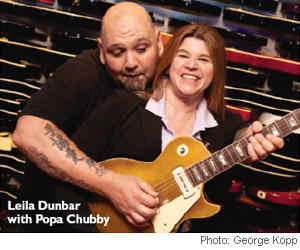“You were at school and you were pimply and no one wanted to know you. You get into a group and you’ve got thousands of chicks there.” —Eric Clapton
 While vintage guitar specialists moon about Martin D-45s, Fender prototypes and Stromberg Masters, others simply want to touch any guitar that Clapton, Garcia or a Beatle picked, strummed or stroked.
While vintage guitar specialists moon about Martin D-45s, Fender prototypes and Stromberg Masters, others simply want to touch any guitar that Clapton, Garcia or a Beatle picked, strummed or stroked.
A 1964 Gibson SG Standard could fetch between $5,000-$15,000, George Harrison’s sold for $560,000 at auction in 2004. Harrison played the SG during the Beatles’ heyday, in fi lms to promote “Paperback Writer” and “Rain,” and John Lennon used it during The White Album dates in 1968.
In the late ’60s-early ’70s Clapton took in Brownie and Blackie, stray 1956-’57 Fender Stratocasters and made them purr, fi rst Brownie, paired with Duane Allman on the famous “Layla” licks on Derek & the Dominos’ Layla and Other Assorted Love Songs. A 1956 Stratocaster sells for $40,000-$80,000, Brownie found a new stage at Paul Allen’s Experience Music Project (EMP) in Seattle for $450,000.
In 1970, Clapton visited the Sho-Bud guitar shop in Nashville where he bought six vintage Stratocasters for $100 apiece. He gave one each to pals George Harrison, Pete Townshend and Steve Winwood, then took the remaining three and assembled “Blackie,” named for its ebony fi nish. Clapton played Blackie for much of the ’70s-’80s, including in The Last Waltz.
In 2004, Blackie sold for $968,000 at a Christie’s auction that, like the Brownie sale, helped support Clapton’s Crossroads Centre. Without the Clapton name a 1956-’57 Strat with “married” parts might bring $10,000-$15,000.
In 1993, the 1968 Stratocaster that Jimi Hendrix played at Woodstock sold for just under €1.3 million to the Italian television host Red Ronnie, who resold it to Paul Allen, who returned it to Hendrix’s hometown of Seattle. A 1968 Strat belonging to a mere mortal sells in the $5,000-$15,000 range.
A Stratocaster made in this decade, signed by Clapton, Page, Jagger, Keith Richards, McCartney, and others was auctioned to benefi t the victims of the Asian Tsunami; in 2005, it sold for $2.7 million, shattering Blackie’s world record. Without the signatures, the charity component or the competitive bidding among sheiks, it would sell in the $2,000-$5,000 range.
In the early 1970s, Jerry Garcia discovered custom builder Doug Irwin. In 1973 Irwin sold Garcia Wolf, for $1,500. Six years later, Irwin fi nished Tiger, named after the tiger inlay on the preamp cover. A hefty guitar at 14 pounds, Garcia played it for 11 years.
When Garcia died in 1995, a nasty battle ensued between Irwin and the surviving band members. A settlement brought Tiger and Wolf back to Irwin. Without the decades of the Dead running through them, they might each sell for $10,000-$30,000. Irwin auctioned Wolf and Tiger in 2002, and Wolf brought $789,500. Indianapolis Colts owner Jim Irsay bought Tiger for $957,500, Garcia playbook not included. —Leila Dunbar
After nine years as Sotheby’s Senior Vice President and Director of the Collectibles Department, Leila Dunbar now runs Leila Dunbar LLC, appraising and consulting in pop culture memorabilia.



[…] http://www.elmoremagazine.com/2009/09/letters/letter-from-the-appraiser-star-guitars […]